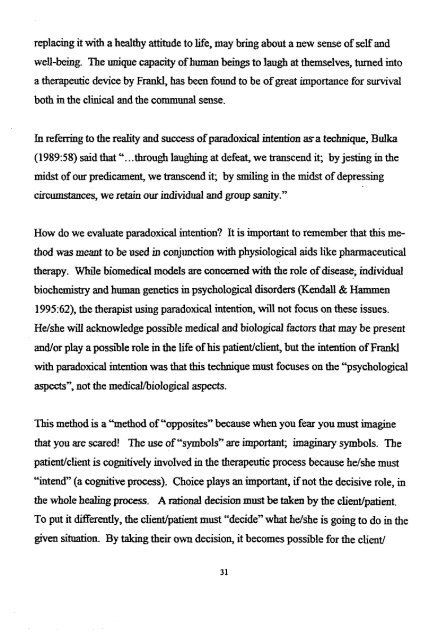View/Open - UZSpace Home
View/Open - UZSpace Home
View/Open - UZSpace Home
Create successful ePaper yourself
Turn your PDF publications into a flip-book with our unique Google optimized e-Paper software.
eplacingit with a healthyattitude to life, may bring about a new sense ofselfand<br />
well-being. The uniquecapacity ofhuman beings to laugh at themselves, turned into<br />
a therapeutic device by Frankl,has been found to be ofgreat importance for survival<br />
both in the clinical and the communal sense.<br />
In referring to the reality and success ofparadoxicalintention as- a technique, Bulka<br />
(1989:58) said that " ...throughlaughing at defeat, we transcend it; by jesting in the<br />
midst of our predicament, we transcendit; by smiling in the midst ofdepressing<br />
circumstances, we retain our individual and group sanity."<br />
How do we evaluate paradoxicalintention? It is importantto remember thatthis me<br />
thodwas meant to be used in conjunction with physiological aids like pharmaceutical<br />
therapy. While biomedical models are concerned with the role ofdisease; individual<br />
biochemistry and human geneticsin psychological disorders (Kendall & Hammen<br />
1995:62), the therapist using paradoxical intention, will not focus on these issues.<br />
He/she will acknowledge possible medicaland biological factors that may be present<br />
and/or playapossible role in the life ofhis patient/client, but the intention ofFrankl<br />
with paradoxical intentionwas that thistechniquemust focuses on the "psychological<br />
aspects", not the medicallbiological aspects.<br />
This methodis a "method of"opposites" because when you fear you must imagine<br />
that you are scared! The use of"symbols" are important; imaginarysymbols. The<br />
patient/client is cognitively involvedin the therapeutic process because he/she must<br />
"intend" (a cognitiveprocess). Choice plays an important, ifnot the decisive role, in<br />
the wholehealing process. A rational decisionmust be taken by the client/patient.<br />
To put it differently, the client/patientmust "decide" what he/she is going to do in the<br />
givensituation. By taking their own decision, it becomes possible for the client!<br />
31
















